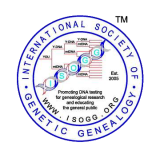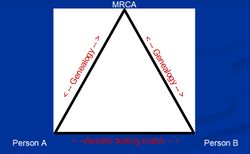Triangulation
From ISOGG Wiki
Triangulation is a term derived from surveying to describe a method of determining the Y-STR or mitochondrial DNA ancestral haplotype using two or more known data points. The term "Genetic Triangulation" was coined by genetic genealogist Bill Hurst in 2004.[1]
Triangulation has been around a long time. It has been used in maps, navigation and within different sciences. For more information, please see: Triangulation types.
Contents
The basics of triangulation for Y-DNA testing
Genetic genealogical triangulation is rather simple. Think of a triangle. /_\
Person A & B match genetically and that forms the base of the triangle. _
Person A has a paper trail (genealogy) that goes back in time. /
Person B has a paper trail that goes back in time. \
The top of the triangle is the MRCA or most recent common ancestor.
For Y-DNA testing: Person A is who you are testing. Some living biological male 2nd, 3rd or better cousin could be Person B. The most common shared ancestor is the MRCA.
For other DNA testing: Person A is who you are testing. Another person is Person B. The most common shared ancestor is the MRCA.
If the genetics of Person A & Person B match and the paper trail goes to the MRCA, then this helps prove they are related both genealogically and genetically. This is the goal of genetic genealogy. The genetics help confirm the paper trails (genealogy) back to the MRCA. When this is repeated several times back to a common ancestor, we then can recreate the DNA markers or genetic fingerprint of that ancestor. All without digging them up!
If there is a break in any point of the triangle, it should be noted appropriately.
- If Person A & B match genetically but either paper trail (genealogy) does not go back to the MRCA, then they match genetically but not genealogically.
- If Person A & B do not match genetically, but match with the paper trails, then they match genealogically, but not genetically. In this case the genealogy may be wrong or there is a formal or informal adoption of DNA into the genealogical line. The later is called a non-paternal event.
When comparing any DNA test using triangulations, one should always cite the common test. For example, When comparing say a 37 marker Y-DNA test with 111 marker Y-DNA test, you should always cite the lower value. Using the example given, a proper statement of genetic triangulation would indicate that Person A & Person B matched genetically and genealogically at 37 Y-DNA markers.
Triangulation with autosomal DNA testing
In autosomal DNA testing triangulation is the term used to describe the process of reviewing the pedigree charts of people who match on the same IBD autosomal DNA segment to see if a common ancestor can be found. The technique is best used in conjunction with chromosome mapping. Triangulation can be used going back many generations. However, well documented pedigrees are necessary for all the matching parties in order to rule out the possibility that the match is not on a more distant line which has not yet been researched. Caution still needs to be exercised when reviewing matches with smaller segments under 15 cMs in size, and especially segments under 10 cMs in size, as many of these are false positive matches.
The process of triangulation is greatly facilitated by the use of third-party tools such as those available from GedMatch and DNAGEDCOM (eg, Don Worth's Autosomal DNA Segment Analyser).
Further reading
Autosomal DNA
- DNA update by Barbara Griffiths. Not just the Parrys - a genealogy blog for all my ancestors, 25 November 2016. Includes a discussion of triangulation from a UK perspective.
- A triangulation intervention by Blaine Bettinger, The Genetic Genealogist, 19 June 2016.
- TG review: 12 kits at FTDNA by Barton Lewis, Barton Lewis's Genealogy Pages, 29 May 2016. An analysis of triangulated groups in 12 kits at Family Tree DNA.
- A triangulation feature on the new 23andMe by Kitty Cooper, Kitty Cooper's Blog, 26 May 2016.
- Autosomal DNA triangulation Part 1: the basics by Debbie Kennett, Cruwys News blog, 28 January 2016.
- Autosomal DNA triangulation Part 2: the phenomenon of triangulated segments by Debbie Kennett, Cruwys News blog, 28 January, 2016.
- An analysis of fourth cousins and other near distant relationships by Jim Owston, Owston/Ouston One-Name Study blog, 10 August 2015. Includes an exercise in triangulation.
- How to triangulate by Jim Bartlett, Segmentology blog, 11 May 2015.
- Genealogy and autosomal DNA matches: common errors in proving an ancestor and the allure of easy gateway ancestors Genealogy and Genomics blog, 19 April 2015.
- The trouble with triangulation: preliminary notes by Ann Turner, 4 April 2015.
- Triangulation: proving a common ancestor by Kitty Cooper, Kitty Cooper's blog, 26 February 2015.
- Technique for segment triangulation when GedMatch tool not available by Sue Griffith, Genealogy Junkie, 28 August 2014.
- Triangulation for autosomal DNA by Roberta Estes, DNAeXplained, 21 June 2013.
- Triangulate to find more meaningful matches using both Family Tree DNA and 23andMe by Randy Majors, Randymajors.com, 15 May 2012
Y-DNA
- One example of a reconstructed Y-DNA haplotype that used Genetic Triangulation. See: William Carpenter of Providence, RI.
- Triangulation An essay from the Taylor Family Genes Project
- Charles Kerchner's definition of triangulation
- Triangulation in genetic genealogy by Emily Aulicino, Genealem blog, 25 March 2008
- Triangulation for Y-DNA by by Roberta Estes, DNAeXplained, 18 June 2013.
Blogs
- Segmentology A blog by Jim Bartlett focusing on triangulation for autosomal DNA testing
See also
References
- ↑ William Hurst. New words for this new field of genetic genealogy. Genealogy-DNA mailing list, 16 December 2004.

